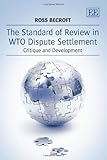The standard of review in WTO dispute settlement: critique and development/ Ross Becroft
Material type: TextPublication details: Cheltenham: Edward Elgar, ©2012Description: xxxvii, 249 p. : ill. ; 24 cmISBN: 9781781002230Subject(s): Foreign trade regulation | World Trade Organization | International commercial arbitrationDDC classification: 382.92
TextPublication details: Cheltenham: Edward Elgar, ©2012Description: xxxvii, 249 p. : ill. ; 24 cmISBN: 9781781002230Subject(s): Foreign trade regulation | World Trade Organization | International commercial arbitrationDDC classification: 382.92 | Item type | Current library | Call number | Status | Date due | Barcode | Item holds |
|---|---|---|---|---|---|---|
|
|
Central Library, Sikkim University General Book Section | 382.92 BEC/S (Browse shelf(Opens below)) | Available | P41073 |
Browsing Central Library, Sikkim University shelves, Shelving location: General Book Section Close shelf browser (Hides shelf browser)
Machine generated contents note: 1.1. importance of WTO oversight of government trade measures --
1.2. Conceptual foundations of standards of review --
1.2.1. definition of standards of review --
1.2.2. Types of standards --
1.2.3. Review of facts versus law --
1.2.4. Rationales for standards of review --
1.2.5. Standards applied in other relevant jurisdictions --
A. Australia --
B. United States --
C. France --
D. European Court of Justice --
E. Selected international dispute settlement bodies --
F. Assessment of other legal systems --
1.3. Application of standards of review in the WTO --
1.3.1. Relevancy, definitions and application --
1.3.2. Institutional considerations and limitations within the WTO system --
1.3.3. Usefulness of the domestic law analogy --
1.4. Argument, methodology and chapter outlines --
1.4.1. Summary of argument --
1.4.2. Methodology --
1.4.3. Chapter outlines --
2.1. Introduction --
2.2. General Agreement on Tariffs and Trade 1947 --
2.2.1. GATT 1947 --
2.2.2. Tokyo Round Codes --
2.2.3. GATT panel decisions --
2.3. Uruguay Round negotiations --
2.4. World Trade Organization --
2.4.1. Decisions prior to EC-Hormones --
2.4.2. EC-Hormones --
2.4.3. Post EC-Hormones --
2.4.4. anti-dumping standard of review --
2.5. Conclusion --
3.1. Introduction --
3.2. Alternative standard of review models --
3.2.1. sovereignty perspective and Chevron analogy --
3.2.2. 'deliberation test' --
3.2.3. 'reasonable regulator' test --
3.2.4. De novo review --
3.2.5. flexible standard of review --
3.2.6. Other theoretical approaches: constitutionalization and harmonization --
3.2.7. Deference based upon a 'margin of appreciation' or 'policy space' --
3.3. Identification of principles for the development of a WTO standard of review --
3.3.1. Relevant principles --
3.3.2. Developing a standard that supports the key aims of WTO dispute settlement --
3.3.3. Ensuring adjudicative legitimacy --
3.3.4. Developing appropriate procedures --
A. Scope of fact-finding and expertise --
B. Efficiency --
C. Procedural fairness --
3.4. Conclusion --
4.1. Introduction --
4.2. Features of a new general standard of review --
4.2.1. requirement to examine all available and sufficient evidence --
4.2.2. requirement to conduct a comprehensive review --
4.2.3. Treatment of facts and law --
4.3. Justifications for a new general standard of review --
4.3.1. legal basis for developing a new standard of review --
4.3.2. Assessment against relevant standard of review principles --
4.3.3. Brief assessment against other standards of review --
4.3.4. relationship with Article 17.6 of the Anti-Dumping Agreement --
4.4. Conclusion --
5.1. Introduction --
5.2. application of a specific standard of review --
5.2.1. threshold test for the modification of the general standard of review --
5.2.2. method of construction of a specific standard of review --
5.2.3. treatment of facts and law --
5.3. Justifications for a specific standard of review --
5.3.1. General arguments for and against a specific standard of review --
5.3.2. legal basis for a specific standard of review --
5.3.3. Assessment against relevant standard of review principles --
5.3.4. Brief assessment against other standards of review --
5.4. Conclusion --
6.1. Introduction --
6.2. Factual and legal issues in reviewing trade remedies --
6.3. Anti-Dumping Agreement --
6.3.1. Key concepts and obligations --
6.3.2. role of Article 17.6 --
6.3.3. application of the new standard to the Anti-Dumping Agreement --
6.4. Agreement on Subsidies and Countervailing Measures --
6.4.1. Key concepts and obligations --
6.4.2. application of the new standard to the SCM Agreement --
6.5. Safeguards Agreement --
6.5.1. Key concepts and obligations --
6.5.2. application of the new standard to the Safeguards Agreement --
6.6. Comparison of the new standard with the current standard applied in trade remedy disputes --
6.6.1. Anti-Dumping Agreement --
6.6.2. SCM Agreement --
6.6.3. Safeguards Agreement --
6.7. Conclusion --
7.1. Introduction --
7.2. Uniformity of the standard of review in non-trade remedy agreements --
7.3. agreement on sanitary and phytosanitary measures --
7.3.1. Key concepts and obligations --
7.3.2. application of the new standard to the SPS Agreement --
7.4. agreement on technical barriers to trade --
7.4.1. Key concepts and obligations --
7.4.2. application of the new standard to the TBT Agreement --
7.5. General Agreement on Tariffs and Trade 1994 --
7.5.1. Key concepts and obligations --
7.5.2. application of the new standard to GATT 1994 --
7.6. Comparison of the new standard with the current standard applied to non-trade remedy disputes --
7.6.1. SPS Agreement --
7.6.2. TBT Agreement --
7.6.3. GATT 1994 --
7.7. Conclusion --
8.1. Overview of this work --
8.1.1. Critique and contentions --
8.1.2. Summary of chapters --
8.2. Directions for future research --
8.3. significance of the standard of review issue for the WTO: concluding remarks.







There are no comments on this title.